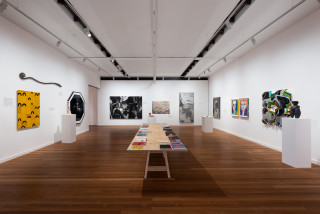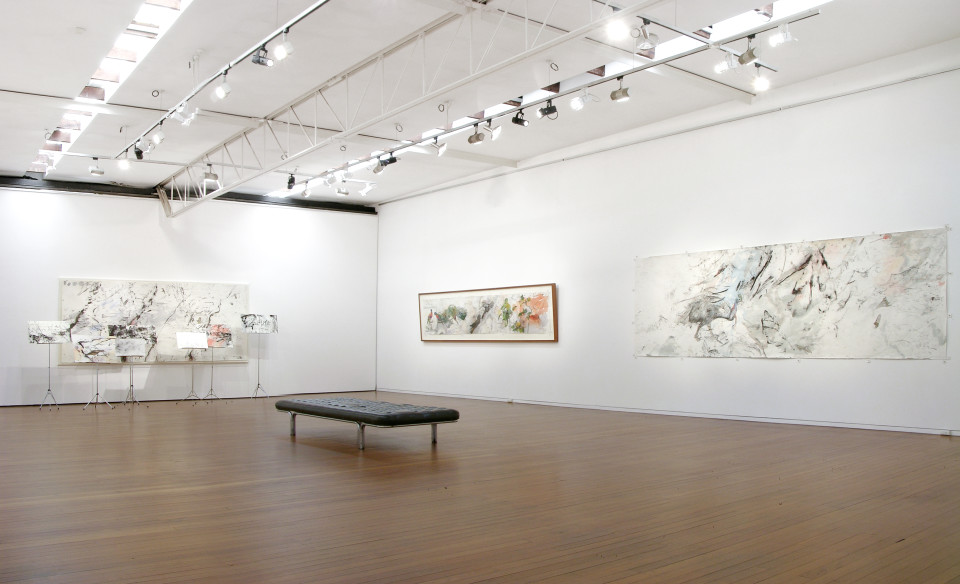After ten years painting the furthest reaches of what was once the supercontinent Gondwana—from the far south of South America to the islands of the Indonesian Archipelago, John Wolseley has returned to the centre of it all—inland Australia. Following a line of fire he has been burning himself back into the Mallee sandhills and Box Ironbark forests of N.W. Victoria.
Exhibition Dates: 29 September – 22 October 2005
INTRODUCTION
After ten years painting the furthest reaches of what was once the supercontinent Gondwana—from the far south of South America to the islands of the Indonesian Archipelago, John Wolseley has returned to the centre of it all—inland Australia. Following a line of fire he has been burning himself back into the Mallee sandhills and Box Ironbark forests of N.W. Victoria. In the Mallee, the raging fires had left skeletal trees of pure carbon—different radiating structures—each species expressing its own particular energy. Sometimes these trees themselves played a part, their blackened fingers doing the drawing; as he moved the paper with different gestures over and within them in a kind of awkward dance. During this kinetic process the twigs and branches drag, stipple and scrape with their own inimitable sound across the paper. The marks have a strangely aural quality, akin to a musical score. And he found that there was a mysterious synergy between these notations and the songs of the birds of that habitat. The harmonics of the birdsong is given graphic form as sonograms which he melted into several of the drawings done by the trees. The intimate centre of this exhibition is an investigation of a barely visible fence which the artist followed for miles and miles through the sand hills in the Wyperfeld National Park. This burnt and broken structure—often nearly erased by the wind and the sand—became for him a poignant symbol of the early settlers' relationship with that land.
SOUND DRAWINGS
Out of the cradle endlessly rocking
Out of the mocking-bird's throat, the musical shuttle … Walt Whitman
I want my drawing to be about moving within land. As I move my paper against and within the burnt trees, I am part of the physical structure of it, and also within the dimension of the sound of it. I have been intrigued by how often my drawings do in fact have the appearance of musical notations. The black lines and rhythmic dots made by hitting and dragging the paper against re-bounding twigs and branches often look like a musical score. I began to realize that some of these marks have a correspondence with sonograms or graphic representations of bird song. Not just any bird song but that of the Gilbert's Whistler or the Hooded Robin which were singing in the very trees I was moving through. It was as if the song and the carbon marks of those trees were both an expression of the energy fields of that particular habitat. Sonograms are now made by passing the sound of the song through a computer program. And they are a graph of the two most important variables of sound: harmonic frequency and the passage of time. They are able to depict the timbre of a bird's song in a more visual way than traditional musical notations.
FENCE DRAWINGS
By the end of the last century most of the Mallee area of N. W. Victoria had been divided on government maps into selector's plots. There seems little connection with these straight linear boundaries and this sea of moving sandhills and unruly scrub. I have found remnants of fences far into the Big Desert Wilderness, forgotten fragments of wire and post which have become emblematic of the failed project to impose inappropriate European farming methods on unwilling ground. The degree to which this linear construct—the fence—remains on the surface of the ground; or has melted to become one with the vital organic processes of the living desert has been the subject of many of my drawings. As I followed it for miles and miles, one particular fence became for me a kind of story about our relationship with the earth. Sometimes the fence still almost acted as a boundary or barrier between one area and another. Further on there would only be minimal lengths of wire lying on the sand like the forgotten underlining to a text which had moved away. Or was this fence one long poem? This idea fitted well with the presence of someone who once lived in this country. John Shaw Neilsen, possibly ’s greatest lyric poet, spent his life in and around the Mallee as an itinerant labourer, farmer and fence-maker. He could even have constructed this fence. And his poetry, like the fence, often hinted at a tension between the wilder flows of nature and the confinement of cultural boundaries.
PARROTS, OWLS AND CASSOWARIES
In 1774 an Otaheite man, Tupia, was taken on board ship by Captain Cook. With him was his pet Rainbow Lorikeet. Tupia died on the trip but the parrot lived for many years in London. The bird figures in Peter Brown's New illustrations of zoology, 1776 and is thus the first image in a European book of an Australian Parrot. I have parroted this illustration and drawn a modern day Lorikeet looking at it. Nearby is a Smoker or Regent Parrot - the subject of several of Shaw Neilsen's poems and now rare and endangered. And in the middle of the painting, I have painted another threatened bird – the South-Eastern Red-tailed Black Cockatoo. In this work, the birds move about in the foliage with a background of sixteenth and seventeenth century maps of the earth annotated with titles like Terra Incognita and Terra in Periculo. Curious elisions and shifts in the cartography hint that disturbing things may be happening. It may be that the map is being pulled from underneath the parrots in a similar way that increased temperatures caused by global warming may force them to move north or south—leaving far behind the feeding grounds and habitat they need to survive.
MALLEE GROUND
Journal entry, 10 April 2005, Big Desert Wilderness
This morning, I finally got the tarp firmly taut, mooring it with ropes tied to Broombush and Banksia stumps. I unscrolled part of my drawing and sat with my head into the wind. I had the feeling of being an ebullient ship sailing magnificently through rough seas—with a fine tarp sail. This mood was intensified by the surgey explosive passages of splosh on the paper together with the wild frot of Banksia marks which had a lot of energy and seems to be asking for the Desert Grevillea regrowth (with old burnt antlers) which I painted in. And another one with some Broombush and some urgent new Banksia sprouts—I felt I was almost replicating the sand dunes exploding into new growth as I drew these plants on the surging waves of watercolour.
—John Wolseley

carbonised wood, watercolour on paper, and music stands
installation, overall approx. 200 x 350 x 150 cm, eight parts (i) 143 x 348 cm; (ii) 37 x 72 cm; (iii) 57 x 76.5 cm; (iv) 30.5 x 54.4 cm; (v) 35 x 84.5 cm; (vi) 31 x 49 cm; (vii) 46 x 67 cm; (viii) 41 x 66.5 cm (paper)

watercolour, pencil and carbonised wood on paper
153 x 264 cm (paper), 179 x 287 cm (framed)

watercolour and carbonised wood on paper
87 x 196 cm (paper), 109.7 x 218 cm (framed)

watercolour and carbonised wood on paper
123 x 300 cm (paper), 148.6 x 326.2 cm (framed)

carbonised wood and watercolour on paper
2 parts: 151.5 x 245 x 7.5; 151.5 x 211.5 x 7.5 cm

watercolour, charcoal and coloured pencils on paper
66.5 x 346 cm (paper), 92 x 372 cm (framed)

carbonised wood, watercolour and coloured pencils on paper
two parts, overall 71.5 x 361 cm (paper), 76.4 x 367 cm (framed)

watercolour and carbonised wood on paper
56 x 228 cm (paper), 77.7 x 248 cm (framed)

watercolour pencil and carbonised wood on paper
56.5 x 151.5 cm (paper), 74.5 x 169 cm (framed)

carbonised wood, watercolour and pencil on paper 12 in separate frames
56.5 x 76 cm (paper), 66.5 x 85.4 cm (framed)

carbonised wood and watercolour on paper
123 x 71 cm (paper), 146 x 89 cm (framed)

carbonised wood, watercolour and pencil on paper
56..5 x 76 cm (paper), 82.7 x 100.7 cm (framed)

watercolour and carbonised wood on paper
56 x 228 cm (paper), 77.7 x 248 cm (framed)
 Group Show, The First 40 Years
Group Show, The First 40 Years
Roslyn Oxley9 Gallery, 2024
 John Wolseley Regenesis - Slow Water - Deep Earth.
John Wolseley Regenesis - Slow Water - Deep Earth.
Roslyn Oxley9 Gallery, 2023
 John Wolseley One Hundred and One Insect Life Stories
John Wolseley One Hundred and One Insect Life Stories
Roslyn Oxley9 Gallery, 2019
 John Wolseley Heartlands and Headwaters
John Wolseley Heartlands and Headwaters
National Gallery of Victoria, Melbourne, 2015
John Wolseley all our relations
18th Biennale of Sydney, 2012
 John Wolseley Carboniferous
John Wolseley Carboniferous
Roslyn Oxley9 Gallery, 2010
 John Wolseley Natural Selection: MALLEE/MAQUIS
John Wolseley Natural Selection: MALLEE/MAQUIS
Roslyn Oxley9 Gallery, 2008
 Group Show, STOLEN RITUAL
Group Show, STOLEN RITUAL
Roslyn Oxley9 Gallery, 2006-07
 John Wolseley The Wood, The World, and The Parrot
John Wolseley The Wood, The World, and The Parrot
Roslyn Oxley9 Gallery, 2006
 John Wolseley Bird on a Wire
John Wolseley Bird on a Wire
Roslyn Oxley9 Gallery, 2005
 Group Show, Dirty Dozen
Group Show, Dirty Dozen
Roslyn Oxley9 Gallery, 2002
 Group Show, The First 20 Years
Group Show, The First 20 Years
Roslyn Oxley9 Gallery, 2002
 John Wolseley Tracing The Wallace Line
John Wolseley Tracing The Wallace Line
Roslyn Oxley9 Gallery, 2001
 Group Show, A constructed world (in collaboration with John Wolsely)
Group Show, A constructed world (in collaboration with John Wolsely)
Roslyn Oxley9 Gallery, 1997



